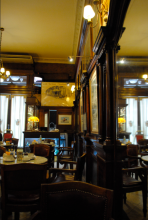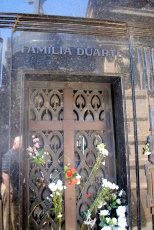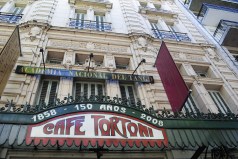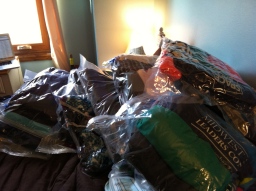Okay Buenos Aires, you win. I like you.
My hotel is in “El Centro” de Buenos Aires. It’s cramped, busy, and hot. But there’s SO MUCH MORE to this city and I’ve really started to love the different neighborhoods.
I got here on Thursday afternoon and since then I’ve been to La Boca, San Telmo, El Centro, Puerto Madero, La Recoleta, and a little of Palermo (I’m spending all day in Palermo tomorrow). Each area of the city is so unique and I’ve really started to appreciate that about Buenos Aires.
Puerto Madero
Puerto Madero is an up-and-coming area in the city. I started out my first full day in Buenos Aires exploring Puerto Madero. The first indication you’re in Puerto Madero is La Puente de la Mujer (pictured above) designed by Calatrava (love the Milwaukee connection!). It’s a nice part of the city but nothing too exiting to report.
El Centro
El Centro contains a whole lot of the city. There’s a few main landmarks throughout that all have a different feel and a different history.
La Avenida de Mayo
La Avenida de Mayo is a grand street that runs into La Plaza de Mayo. La Avenida has gorgeous European-inspired architecture, a grand street, large sidewalks lined with trees, shops, and cafes. It’s beautiful and quickly became my favorite street in Buenos Aires.
It’s also home to Café Tortoni. This cafe was founded in 1858 and has so much history within. Most of the tables are original, and gorgeous artwork and beautiful chandeliers fill the cafe. In the 1900s the cafe was primarily visited by artists, poets, writers, musicians, and journalists, and entering the doors makes you feel like you’re stepping back into a grand cafe from the 1900s.
 I’ve visited the cafe twice now since getting to Buenos Aires, and have enjoyed a refreshing iced coffee both times. It’s a nice place to relax and cool down from the 90-degree Buenos Aires days and I know I would spend a lot more time here if I was living in the city. It’s a little touristy (and by a little, I mean a lot), but I understand why.
I’ve visited the cafe twice now since getting to Buenos Aires, and have enjoyed a refreshing iced coffee both times. It’s a nice place to relax and cool down from the 90-degree Buenos Aires days and I know I would spend a lot more time here if I was living in the city. It’s a little touristy (and by a little, I mean a lot), but I understand why.
La Plaza de Mayo
At the end of La Avenida de Mayo, you will find La Plaza de Mayo. It’s known for protests and it’s main monument is to remember Los Desaparecidos. During the 1970s, La Guerra Sucia (the dirty war) was going on in Argentina — this period is known as an era of state terrorism and guerrilla warfare. About 30,000 people were “disappeared” in Argentina during La Guerra Sucia.
 The Mothers of the Plaza de Mayo is the best known Argentinian human rights organization, and the mothers have campaigned for over 30 years to find out what happened to their lost relatives. They still gather every single Thursday afternoon to remember Los Desparecidos.
The Mothers of the Plaza de Mayo is the best known Argentinian human rights organization, and the mothers have campaigned for over 30 years to find out what happened to their lost relatives. They still gather every single Thursday afternoon to remember Los Desparecidos.
There are lots of signs of La Guerra Sucia y los Desaparecidos in Plaza de Mayo still today, and signs and graffiti serve as constant reminders of the sad history of Argentina during this time.
Plaza del Congreso
 Plaza del Congreso is exactly what you think it is. The plaza in front of the building where Congress meets. Nothing too much to say about Congreso, other than the fact that the actual building itself is beautiful. There’s a huge monument in front of the building (pictured above) that used to have a fountain in front of it. But starting in the 1990s they had to fence it in because people used the fountain as a swimming pool, a place to do laundry, a place to soak your feet, etc.
Plaza del Congreso is exactly what you think it is. The plaza in front of the building where Congress meets. Nothing too much to say about Congreso, other than the fact that the actual building itself is beautiful. There’s a huge monument in front of the building (pictured above) that used to have a fountain in front of it. But starting in the 1990s they had to fence it in because people used the fountain as a swimming pool, a place to do laundry, a place to soak your feet, etc.
La Recoleta
La Recoleta, to me, was like a breath of fresh are from the chaos in El Centro. It’s known as a wealthier part of town and there’s some interesting history behind this. Apparently Buenos Aires had a bad cholera/yellow fever epidemic in the 1870s and that’s when the city started to expand, to avoid contagion. The lower class settled in the south/southwest of the city (where La Boca is), and the wealthiest settled in La Recoleta because it’s on higher ground and the were less disease-transmitting insects.
Anyway, I started my day in La Recoleta with some café con leche out on the terraza of a great little cafe. This was probably the moment when I first could say “Wow, I love Buenos Aires.” I had a great waiter who was actually attentive (this is uncommon here). He brought me an excellent cup of café con leche and let me tell him exactly how much coffee and how much milk I wanted. Looking around I saw lots of old couples and friends enjoying a cup of coffee and reading the newspaper on a Sunday morning. There’s just something about coffee on a terrace that makes me love Spanish-speaking countries, I guess.
 After that I started to explore the massive Cementerio de la Recoleta. Now it might seem odd to spend a lot of time in a cemetery, but this is not an ordinary cemetery. La Recoleta is home to the graves of the richest, most prominent people in Argentinian society including politicians, authors, lawyers, doctors, military generals, and professors. These are not normal graves in the ground with a simple tombstone, either.
After that I started to explore the massive Cementerio de la Recoleta. Now it might seem odd to spend a lot of time in a cemetery, but this is not an ordinary cemetery. La Recoleta is home to the graves of the richest, most prominent people in Argentinian society including politicians, authors, lawyers, doctors, military generals, and professors. These are not normal graves in the ground with a simple tombstone, either.
These are huge monuments made of marble, granite, or some other stone. They have statues on top, domes, stained glass, gates, fences, quotes and prayers, plaques, brass wreathes, etc. I have never seen anything like this in my entire life. Walking through I couldn’t help but appreciate the perspective on death in most Latin American cultures — of cherishing and celebrating the dead, rather than mourning a loss. It’s the idea of really appreciating the person instead of sadly remembering old memories.
I was able to find Evita’s grave in the massive cemetery. It’s not proudly on display in the center of anything. It’s off near the back, left-hand corner of the cemetery down a basic row of graves. She is buried in the same place as other members of her family. She was diagnosed with cervical cancer and although she was the first Argentine to undergo chemotherapy, she died from the disease in 1952. She was only 33.
 Initially they were going to make a huge memorial in her honor, but her corpse disappeared from 1955 until 1971 as the military dictatorship of Argentina issued a ban on Peronism. It became illegal to have pictures of Juan or Eva Perón and to even speak their names. In 1971, Evita’s body was exhumed and flown to Spain. Juan Perón was married to his 3rd wife at the time, and they decided to keep the corpse in their dining room (don’t ask, I don’t know). In 1973 Juan Perón came back to Argentina, out of exile, and he became president again. Eventually her body was buried in Recoleta with the rest of the Duarte family (pictured).
Initially they were going to make a huge memorial in her honor, but her corpse disappeared from 1955 until 1971 as the military dictatorship of Argentina issued a ban on Peronism. It became illegal to have pictures of Juan or Eva Perón and to even speak their names. In 1971, Evita’s body was exhumed and flown to Spain. Juan Perón was married to his 3rd wife at the time, and they decided to keep the corpse in their dining room (don’t ask, I don’t know). In 1973 Juan Perón came back to Argentina, out of exile, and he became president again. Eventually her body was buried in Recoleta with the rest of the Duarte family (pictured).
Rotary Connection
Today I met up with two other Rotary Ambassadorial Scholars (let’s abbreviate with RAS from now on). Melanie is from California and is going to be getting a Master’s in International Relations here in Buenos Aires, in the Recoleta neighborhood. Nate is from Pennsylvania and is getting an MBA out in Pilar, a city about 40 miles northwest of Buenos Aires. Nate and I had the same Pre-Departure Orientation in Kansas City so we met last March. Melanie had other things to take care of in the afternoon, so that left Nate and I to explore more of Buenos Aires. Nate bought a car because Pilar is kind of a suburb and it’s hard to get from there to Buenos Aires easily. So he bravely (seriously, bravely) volunteered to drive around the city with me. For more information on driving in Buenos Aires, click here.
La Boca
La Boca is considered one of the sketchier neighborhoods of La Boca, so I was happy when Nate agreed to go there with me. We found a place to park his car and wandered into La Boca stadium. For those of you who don’t know much about soccer or Latin America, La Boca is A HUGE TEAM here and soccer is THE BEST SPORT OF ALL TIME. So for $10 each we were able to look at the small little museum and go in to see the field.
We started talking to a really, really nice girl about our age who was working at the field. Nate was trying to convince her to let us go see the locker rooms, and although that didn’t work, she told us SO MUCH about the team, the history, the stadium, the games, and how to get tickets.
After exploring the stadium and museum, we set off to talk around San Telmo. Immediately I realized that it was indeed a pretty sketchy part of the city as soon as you left the main tourist areas. We walked around and looked at all the brightly colored buildings and settled in for lunch at a little restaurant. After getting back in Nate’s car and heading back towards El Centro, we ended up driving down a street bordered on either side by the homeless population of San Telmo and I was reminded of the sad reality of any big city in the world.
Despite that unfortunate reminder of worldwide poverty, it was a great day getting to see another part of Buenos Aires. I am thankful for other RAS living in Argentina because I know that anytime I want to return to Buenos Aires I’ll have friends here and (hopefully) a place to stay.











